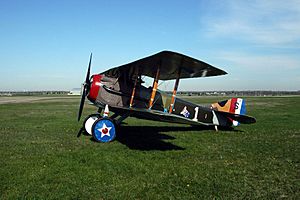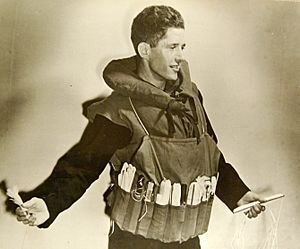Eddie Rickenbacker facts for kids
Quick facts for kids
Eddie Rickenbacker
|
|
|---|---|
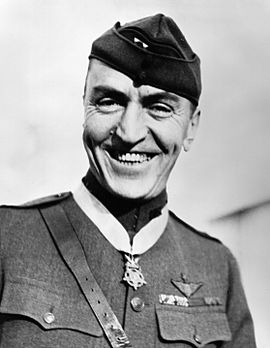
Rickenbacker wearing the Medal of Honor
|
|
| Birth name | Edward Vernon Rickenbacher |
| Nickname(s) |
|
| Born | October 8, 1890 Columbus, Ohio, U.S. |
| Died | July 23, 1973 (aged 82) Zürich, Switzerland |
| Buried |
Green Lawn Cemetery
|
| Military career | |
| Allegiance | United States |
| Service/ |
United States Army Air Service |
| Years of service | 1917–1919 |
| Rank | Captain |
| Commands held | 94th Aero Squadron |
| Battles/wars | World War I |
| Awards |
|
| Other work | |
Edward Vernon Rickenbacker (born October 8, 1890 – died July 23, 1973) was an American hero. He was a brave fighter pilot in World War I and received the Medal of Honor. With 26 victories in the air, he was the most successful and honored American flying ace of the war. Before and after his military service, he was also a famous race car driver, a car designer, and led Eastern Air Lines for many years.
Contents
Growing Up in Ohio
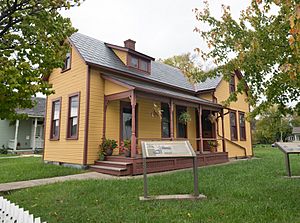
Edward Rickenbacher was born in Columbus, Ohio. He was the third of eight children. His parents were Swiss immigrants who spoke German. Later in his life, he changed his last name to Rickenbacker and added "Vernon" as his middle name.
His family worked hard. His father worked in breweries and on street-paving crews. His mother took in laundry to earn extra money. They even built a small home in 1893, where Eddie spent his childhood. The house didn't have running water or electricity.
As a kid, Eddie worked before and after school. He helped in the family garden, raising vegetables and animals. He also delivered newspapers and set up pins at a bowling alley. He gave most of his earnings to his mother.
Eddie was quite adventurous and had many close calls as a child. He once walked into the path of a horse-drawn streetcar and fell into a deep hole. He also ran back into his burning school to get his coat! Years later, he believed these escapes meant he was saved for a special purpose.
He also had an artistic side, enjoying painting. He even tried to invent a machine that would run forever! Eddie was also a leader of a group of friends called the Horsehead Gang. They built pushcarts, which were like early versions of Soapbox Derby cars. Once, his leg was badly hurt during a ride in a quarry cart. After the Wright brothers first flew, Eddie famously tried to "fly" a bicycle with an umbrella off a barn roof!
When Eddie was almost 14, his father died after an injury. This made Eddie feel responsible to help his family. He left seventh grade and started working full-time, even lying about his age to get jobs.
Starting His Career
Eddie worked many different jobs. In 1905, he worked at the Oscar Lear Automobile Company. There, he took an engineering course and learned a lot from chief engineer Lee Frayer.
Frayer took Eddie to New York for the 1906 Vanderbilt Cup race. Eddie was his riding mechanic, helping with the car during the race. This was his first taste of professional racing.
Back in Columbus, Eddie followed Frayer to the Columbus Buggy Company. At just 16, he was a chief testing engineer, in charge of many men. His hard work impressed Harvey S. Firestone, his new boss. Firestone sent Eddie on special assignments, even to the 1909 Chicago Automobile Show.
Later, Firestone sent Eddie to Texas to fix engine problems. Eddie solved the problem and stayed to manage the company's Dallas office. At 18, he was in charge of everything from engineering to sales. He even drove William Jennings Bryan, a famous politician, which got his cars in the newspaper.
Racing Cars: "Fast Eddie"

To promote his company's car, Eddie entered a race in Iowa. He crashed in his first race, but he didn't give up. That summer, he won most of the dirt track races he entered. Newspapers often misspelled his name, but eventually, they settled on Rickenbacker.
In May 1911, Eddie was invited to the first-ever Indianapolis 500. He was a relief driver, helping his former boss finish 13th. The next year, he drove by himself but had to stop due to mechanical issues. He then quit his sales job to race full-time.
In 1912, Eddie was banned from racing for a year due to safety rule violations. During this time, he worked long hours developing a new race car. In 1913, he was allowed to race again and won three times. By 1914, he was a national racing star, earning the nickname "Fast Eddie." One writer called him "the most daring and...the most cautious driver in America today."
In 1915, he joined the Maxwell team and finished fifth among all racers, with three wins. He also got financial support to lead a new racing team. Around this time, he officially changed his name to Rickenbacker and added the middle initial "V."
In 1915–16, Rickenbacker continued winning races. He was one of the most famous race car drivers in America, earning a lot of money.
Before joining a British racing team in 1917, Eddie sailed to England. He was stopped by police because a newspaper article had falsely claimed he was a German "Baron." With World War I happening, they thought he might be a spy. He was watched closely during his six weeks in England. This experience made him officially change his name to Rickenbacker to sound more American.
World War I: Flying Ace

While in England, Eddie saw airplanes flying and started thinking about joining the air force if the U.S. entered the war. He had already had his first airplane ride and even helped fix a military plane.
After the U.S. declared war in April 1917, Eddie suggested creating an air squadron of race car drivers. He believed their skills in judging speed and understanding engines would be perfect for flying.
Becoming a Pilot
In mid-1917, Eddie went to France and joined the U.S. Army. He started as a driver for Army officials, including Major Townsend F. Dodd, who became an important contact. Eddie was a Sergeant First Class.
A chance meeting led him to become chief engineer at a new flight school in France. He convinced them to let him learn to fly at a French flight school. He received five weeks of training in September 1917. Then, he helped build the U.S. Air Service's training facility.
For the next three months, Eddie continued his flight training, practicing new moves on his own. In January 1918, he finally got into gunnery school, the last step to becoming a fighter pilot.
In February and March, Lieutenant Rickenbacker completed advanced training. He learned a lot from French flying ace Major Raoul Lufbery. Rickenbacker said, "All I learned, I learned from Lufbery." The other pilots respected him and called him "Rick."
His squadron, the 94th, chose an "Uncle Sam stovepipe hat" as their symbol, earning them the nickname "The Hat-in-the-Ring Gang."
First Air Battles
Eddie's first flight was on April 13, 1918, and it was almost a disaster due to fog. But two weeks later, on April 29, he shot down his first enemy plane. By May 28, he had five victories, making him an "ace" (a pilot with five or more confirmed kills). He also received the French Croix de Guerre award.
He got his sixth victory on May 30, but then he got sick with a fever and ear infection. He was grounded for over three months. While recovering, he thought about how to become a better pilot, deciding he needed more self-control.
Eddie returned to flying in September 1918. By this time, his squadron had switched to the stronger Spad S.XIII airplanes, which fit his fighting style well. He quickly scored more victories. Because of his improved performance, Lieutenant Rickenbacker was chosen to lead the 94th Squadron.
Leading the 94th Aero Squadron
Rickenbacker worked hard to make his squadron a strong team again. He told his pilots to stay focused and reminded the mechanics how important their work was. He promised to always stick by them and never ask them to do anything he wouldn't do himself. To prove it, he flew a solo patrol the next morning and shot down two enemy planes. These victories earned him the Medal of Honor, which he received in 1931.
He also focused on destroying enemy observation balloons, which were dangerous but important targets. Rickenbacker led large raids with many planes. He was like a football coach, planning strategies and tactics for air battles. He was credited with shooting down five balloons.
Rickenbacker taught his squadron new rules for fighting:
- Never attack unless you have a good chance of success.
- Always stop fighting if it seems hopeless.
- Know the difference between being scared and being smart.
He flew more patrols and spent more hours in the air than any other pilot. He brought down 15 aircraft in the last six weeks of the war. In September 1918, he became a Captain. By the end of the war, the 94th Squadron had the most air victories of all American squadrons.
When the war ended on November 11, 1918, Rickenbacker flew over the "No Man's Land" (the area between enemy trenches) to watch the ceasefire. He saw soldiers from both sides come out of their trenches, throwing their helmets and guns in the air, celebrating.
Military Achievements
Rickenbacker received the Distinguished Service Cross eight times, which was a record. In 1930, one of these awards was upgraded to the Medal of Honor. He also received awards from France: the Legion of Honor and the Croix de Guerre.
He shot down 26 enemy aircraft during the war, making him the top American "ace of aces." His record stood until Richard Bong achieved 40 victories in World War II.
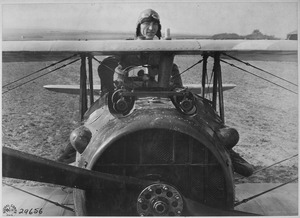
| Verified Aerial Victory | Date | Time | Aircraft | Opponent | Location |
|---|---|---|---|---|---|
| 1 | Apr 29, 1918 | 1810 | Nieuport | Pfalz D.III | Baussant |
| 2 | May 7, 1918 | 0805 | Nieuport | Pfalz D.III | Pont-à-Mousson |
| 3 | May 17, 1918 | 1824 | Nieuport | Albatros D.V | Ribécourt |
| 4 | May 22, 1918 | 0912 | Nieuport | Albatros D.V | Flirey |
| 5 | May 28, 1918 | 0925 | Nieuport | Albatros C.I | Bois de Rate |
| 6 | May 30, 1918 | 0738 | Nieuport | Albatros C.I | Jaulny |
| 7 | Sep 14, 1918 | 0815 | SPAD XIII | Fokker D.VII | Villecy |
| 8 | Sep 15, 1918 | 0810 | SPAD XIII | Fokker D.VII | Bois de Warville |
| 9 | Sep 25, 1918 | 0840 | SPAD XIII | Fokker D.VII | Billy |
| 10 | Sep 25, 1918 | 0850 | SPAD XIII | Halberstadt C | Foret de Spincourt |
| 11 | Sep 26, 1918 | 0600 | SPAD XIII | Fokker D.VII | Damvillers |
| 12 | Sep 28, 1918 | 0500 | SPAD XIII | Balloon | Sivry-sur-Meuse |
| 13 | Oct 1, 1918 | 1930 | SPAD XIII | Balloon | Puzieux |
| 14 | Oct 2, 1918 | 1730 | SPAD XIII | Hannover CL | Montfaucon |
| 15 | Oct 2, 1918 | 1740 | SPAD XIII | Fokker D.VII | Vilosnes |
| 16 | Oct 3, 1918 | 1707 | SPAD XIII | Balloon | Dannevoux |
| 17 | Oct 3, 1918 | 1640 | SPAD XIII | Fokker D.VII | Cléry-le-Grand |
| 18 | Oct 9, 1918 | 1752 | SPAD XIII | Fokker D.VII | Dun-sur-Meuse |
| 19 | Oct 10, 1918 | 1552 | SPAD XIII | Fokker D.VII | Cléry-le-Petit |
| 20 | Oct 10, 1918 | 1552 | SPAD XIII | Fokker D.VII | Cléry-le-Petit |
| 21 | Oct 22, 1918 | 1555 | SPAD XIII | Fokker D.VII | Cléry-le-Petit |
| 22 | Oct 23, 1918 | 1655 | SPAD XIII | Fokker D.VII | Grande Carne Ferme |
| 23 | Oct 27, 1918 | 1450 | SPAD XIII | Fokker D.VII | Grand Pre |
| 24 | Oct 27, 1918 | 1505 | SPAD XIII | Fokker D.VII | Bois de Money |
| 25 | Oct 27, 1918 | 1635 | SPAD XIII | Balloon | St. Juvin |
| 26 | Oct 30, 1918 | 1040 | SPAD XIII | Balloon | Remonville |
Life After World War I
War Hero and Author
Rickenbacker returned home as a war hero. People cheered him and wanted his autograph. He turned down movie deals and endorsements because he didn't want to cheapen his image.
He wrote a book about his war experiences called Fighting the Flying Circus. He also went on a speaking tour to promote Liberty bonds, which helped the country. He left the army in November 1919, but he chose to keep the rank of Captain, saying it was the only rank he truly "earned and deserved." People called him "Captain Eddie" for the rest of his life.
Car Company and Speedway Owner
In 1919, Rickenbacker helped create the Rickenbacker Motor Company (RMC). He designed the car, focusing on reducing vibration. The Rickenbacker car was known for its quality. In 1923, he added four-wheel brakes, a new feature for cars at the time. However, the company faced challenges and went out of business in 1927.
On November 1, 1927, Rickenbacker bought the Indianapolis Motor Speedway for $700,000. He ran the Speedway for over ten years, making many improvements. He was responsible for the first radio broadcast of the famous Indianapolis 500 race. He closed the Speedway during World War II to save resources and later sold it in 1945.
Leading Eastern Air Lines
Rickenbacker became a leader in the airline industry. He helped merge two airlines to form Eastern Air Lines. In 1938, he bought the company himself for $3.5 million.
Under his leadership, Eastern Air Lines grew into a major airline. He worked with the government to get air mail routes, which provided steady income. He also helped develop and buy larger and faster airplanes, like the four-engine Lockheed Constellation. He worked with famous aircraft designers like Donald W. Douglas.
Comic Strips
From 1935 to 1940, Rickenbacker wrote the popular Sunday comic strip, Ace Drummond. It followed the adventures of a pilot named Drummond who traveled the world and fought bad guys. The comic was also made into a film series and a radio show.
He also created another comic strip called The Hall of Fame of the Air. This comic shared true stories about famous aviators and air battles. His name on the comic made it feel very real and exciting.
World War II: Civilian Support
Rickenbacker supported the war effort as a civilian. He encouraged Americans to help Britain during the Battle of Britain in 1940. He believed the U.S. would eventually join the war.
In 1942, he visited military bases in England and the U.S. to boost morale and support. He also worked with the British and American air forces on bombing strategies. Eastern Air Lines, under his direction, flew supplies across the Atlantic to the British.
Lost at Sea
In October 1942, Rickenbacker was sent on a secret mission to the Pacific to deliver a message to General Douglas MacArthur. His plane, a B-17 Flying Fortress, flew hundreds of miles off course due to faulty navigation equipment. When it ran out of fuel, the pilot had to land the plane in the Pacific Ocean.
For 24 days, Rickenbacker, his friend Hans Adamson, and six crewmen were adrift at sea in life rafts. Their food ran out after three days. On the eighth day, a seagull landed on Rickenbacker's head. He caught it, and the bird became food and fishing bait for the men. They survived on rainwater and small fish they caught. One crewman died after two weeks.
The U.S. Army and Navy were about to stop searching, but Rickenbacker's wife convinced them to keep looking. Newspapers even reported that Rickenbacker was dead.
The surviving men eventually split up. Some were rescued on day 23, and the others, including Rickenbacker, were rescued on day 24 by a U.S. Navy plane. They were all very weak from exposure, sunburn, and hunger. After a few days of rest, Rickenbacker completed his mission and delivered the message to General MacArthur.
This event led to better navigation tools and improved survival gear for air crews. In 1943, Rickenbacker wrote a book about his experience called Seven Came Through.
Mission to the Soviet Union
Still wanting to help the war effort, Rickenbacker suggested a trip to the Soviet Union to help them with their American aircraft. He got permission from Soviet officials and the U.S. War Department.
In April 1943, Rickenbacker began his trip, visiting bases and factories in many countries, including Egypt, India, China, Iran, and the Soviet Union. He observed wartime conditions and shared his knowledge of aircraft. He even managed to see a secret map of Soviet military units and tour an aircraft factory.
After his return, British Prime Minister Winston Churchill interviewed him. For his support during the war, Rickenbacker received the Medal for Merit from the U.S. government.
Later Life
Eastern Air Lines became very successful after the war. However, its fortunes declined in the late 1950s. Rickenbacker stepped down as CEO in 1959 and as chairman of the board in 1963.
In the 1960s, Rickenbacker became a well-known speaker. He talked about the future of technology and business. He also encouraged Americans to respect the Soviet Union during the Cold War while upholding American values.
In 1967, Rickenbacker published his autobiography.
Family Life
Rickenbacker married Adelaide Frost Durant in 1922. They adopted two boys, David Edward and William Frost. The family lived in Detroit, then Grosse Pointe, Michigan, and later in Bronxville, New York. New York City remained their main home.
In 1941, Rickenbacker was in a plane crash in Georgia. He was badly hurt and almost died. He was left for dead by some rescuers, but he fought to stay alive. After months in the hospital and at home, he recovered.
Rickenbacker enjoyed playing golf. He traveled with his wife after he left Eastern Airlines.
In 1972, Rickenbacker had a stroke. He recovered and traveled to Zürich, Switzerland in July 1973 for his wife's eye treatment. While there, he got pneumonia and died at age 82. He was buried in Columbus, Ohio. When he died, Rickenbacker was the last living Medal of Honor recipient from the U.S. Army Air Service.
His wife, Adelaide, died in 1977 at age 92.
Awards and Honors
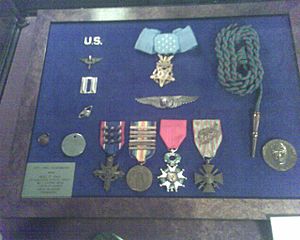
Military Awards
- Junior Military Aviation Badge
- Mackay Trophy for shooting down 16 enemy aircraft (1918)
- Croix de Guerre with Palm from France (May 1918)
- Legion of Honour (Chevalier) from France (May 1918)
- Distinguished Service Cross eight times (one was replaced by the Medal of Honor in 1930)
- World War I Victory Medal
- Medal of Honor (awarded November 6, 1930)
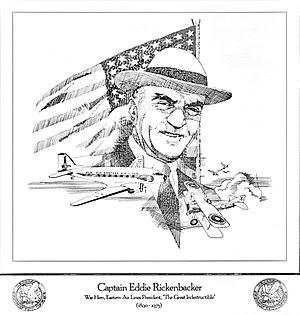
Other Awards and Honors
- Medal for Merit for his civilian efforts during World War II
- Indianapolis Motor Speedway Hall of Fame (1954)
- Automotive Hall of Fame (1973)
- International Motorsports Hall of Fame (1992)
- National Sprint Car Hall of Fame (1992)
- Motorsports Hall of Fame of America (1994)
- Georgia Aviation Hall of Fame (1999)
- National Aviation Hall of Fame (1965 and 2004)
- Dobbins Air Reserve Base in Georgia was originally named Rickenbacker Field in his honor (1941).
- The Rickenbacker Causeway in Miami, Florida, is named after him (1947).
- Rickenbacker Air Force Base in Columbus, Ohio, was renamed for him (1974).
- The Rickenbacker Award is a cadet achievement award in the Civil Air Patrol.
- The United States Postal Service issued a postage stamp honoring him as an aviation pioneer (1995).
- His childhood home in Columbus, Ohio, is a historic landmark.
Images for kids
See also
 In Spanish: Eddie Rickenbacker para niños
In Spanish: Eddie Rickenbacker para niños



